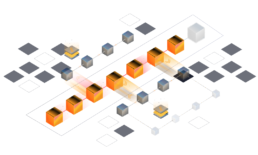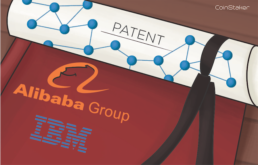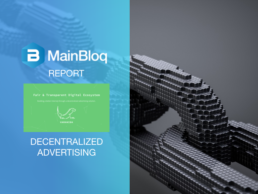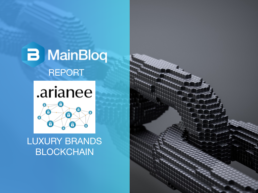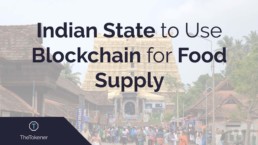Mainbloq launches Streaming Smart Order Router for trading cryptocurrency
We are thrilled to officially release our first "TradeBloq" module which is the first of its kind, and a critical part of the infrastructure needed for the digital asset markets to scale efficiently.

- Mainbloq offers best execution to sophisticated digital asset traders through their xSOR Smart Order Router which has direct, streaming connections to exchanges for the fastest and best execution.
- Their Smart Order Router is live and currently trading cryptocurrency for their clients.
- Each client receives a dedicated Smart Order Router to execute from.
- The Smart Order Router can be used stand-alone or can be integrated into other trading platforms via API.
Mainbloq launched their Streaming Smart Order Router for trading digital assets. The Router has direct market access via streaming connections to exchanges enabling the fastest execution. It executes cross-exchange trades for the best price with the click of one button.
"We've heard a lot of the other platforms talk about their plans to build a Smart Order Router," said CEO Peter Bordes, "but we are live today and know we have the best, most sophisticated technology. Our system is built by a team of Wall Street trading veterans looking to bring the sophistication of the street to digital assets."
"Not all smart order routers are created equal," said CIO Marc Deveaux, "The purpose of a Smart Order Router is best execution, so if you're using a third party servers and APIs you're already behind. We create direct, streaming connections to exchanges to snipe as quickly as possible. Our process for normalizing data is unparalleled."
Mainbloq's Smart Order Router currently has connections to over 100 exchanges and can trade over 30,000 currency pairs.
"This is just the beginning," said Peter Bordes. "We're building a best-in-class cloud-based modular platform joining data, tools, research, and insights for digital assets. It's time that crypto got more sophisticated."
About Mainbloq
Mainbloq is a data, research, and technology company focusing on blockchain and digital assets. Their streaming Smart Order Router gives clients access to cross-exchange pools of liquidity with direct, streaming connections to exchanges for the fastest and best execution. Mainbloq offers a cloud-based modular platform, and suite of trading algorithms, the ability for clients to integrate their own algorithms, and consulting services to help client's execute on their trading strategies. Mainbloq is building the best-in-class platform for researching and trading digital assets. For more information visit www.mainbloq.io.
Contact
Ryan Kuiken
Ryan@mainbloq.io
VP, Sales and Business Development
Future of Cryptocurrency: A Complete Overview
Today, crypto-currencies have become a worldwide phenomenon known to most people.
Banks, governments and many companies are aware of its importance. Industries from E-commerce development companies, Fintech to logistics, and digital marketing are all trying to justify its importance their use of crypto-currencies, even if they are still a little geeky and misunderstood by most people, but banks, governments, and many businesses are aware of its importance as a global digital transformation layer.
What is cryptocurrency?
The term cryptocurrency refers to cryptology and currency of course. Here, the term crypto reminds us of the Greek word Kruptos which means hidden. Moreover, it is used in the prefix to designate hidden or little-known practices as in cryptozoology. Be careful however, cryptocurrency does not mean hidden currency! Transparency is what makes this system a rolling business, we will come back to it later. Here, we speak of crypto in the sense that the information relating to the holders of funds is not retained by any "governing entity". Nobody will remember your personal details.
What are cryptocurrencies for?
Cryptocurrencies are used as fiduciary money in general. They circulate for the payment of goods and services abroad according to the value which they are attributed. These values are of course predefined and are influenced by the popularity of cryptocurrency on the market. It should be known that cryptocurrencies that are losing popularity are also losing their value. The more cryptocurrency you have, the more you will be able to buy goods and services payable by this virtual currency. One YouTuber even experienced living with bitcoin cryptocurrency for 30 days and he kept his bet except in public transport.
So, Cryptocurrency allows you to pay your rent, food, clothes, and much more if you go to sellers or renters who use it as an official bargaining chip. If you travel to the US for example, you will be able to fully enjoy the bitcoins you've saved recently. Aside from that, cryptocurrencies are also put on sale. To get some, you will have to buy some.
However, it is possible to obtain it by other means, but so far it is the most adopted way in the world to have it. When you bought your cryptocurrency, you should always check the prices before spending them. Just to be vigilant, the best is to make sure you have real values before you do anything. Indeed, if you spend your virtual currencies when they lose in value you will be well disappointed. So, between buying and spending your cryptocurrency, you always have to be aware of trends.
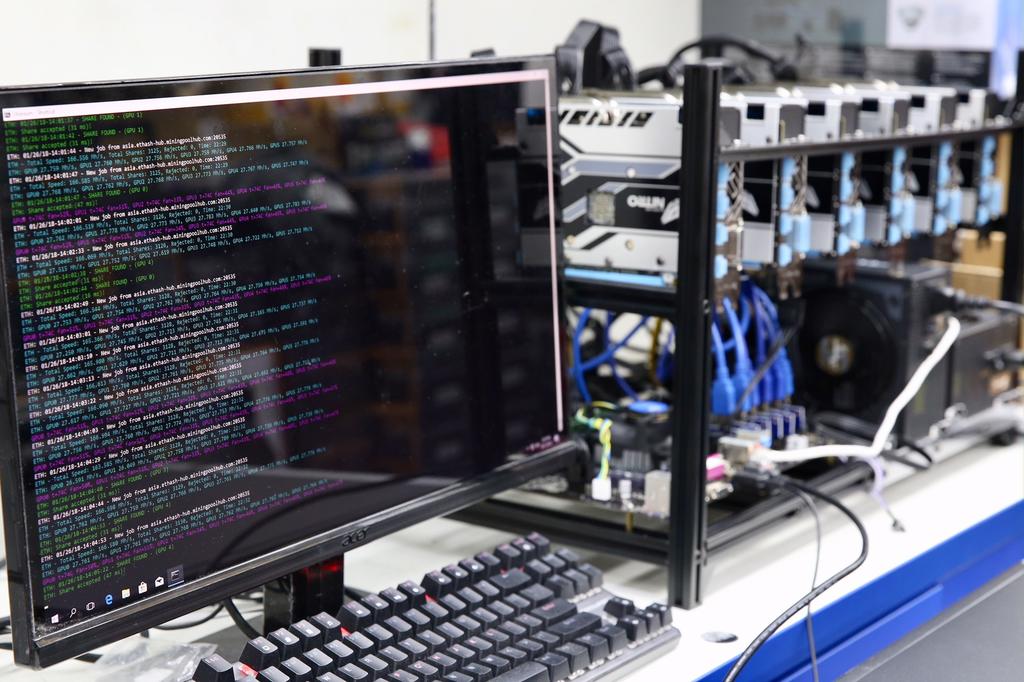
There is no cryptocurrency without mining
For virtual currencies to circulate, they must be verified. A competent institution must be able to verify each transaction to attest to the reality of the value circulating. In a classic world, audits are done by banks and various financial institutions. If we want to withdraw money from our bank card for example, the bank will check our available balance before granting us the amount we ask to have. In the field of cryptocurrencies, verifications are done on the blockchain or block chains. In addition, the blockchain is a set of calculators that take note of all cryptocurrency transactions that have been made since the very beginning.
Whatever type of cryptocurrency we use, transactions will be recorded on the blockchain. In this network, each transaction forms a block and all transactions are visible to the general public. As the demand for computing power increases day by day, the blockchain must be supported by third-party computers. It can be you or me as anyone ready to lend the power of its processor to strengthen the system. Indeed, as all transactions are peer-to-peer exchanges must be followed closely by calculators.
This is where mining comes in. So people who are willing to mine to help the network register on a mining platform. Then, they will simply lend the computing power of their computer so that the cryptocurrency network can work. In mining, minors receive a percentage in cryptocurrency. Generally, the miners receive Ethereum but they can exchange them in bitcoin.
Why are cryptocurrencies so popular?
Cryptocurrencies began to invade the world of Internet users in 2013. Talking about bitcoin has become commonplace and winning Ethereum, ripple, Cardano, Bitcoin Cash and so on, has become normal. Of course, the trend is not yet global, but it is beginning to take over internationally. So, why are cryptocurrencies so fashionable? People who use cryptocurrency rely heavily on the value of each token (cryptocurrency unit) they use. But above all, cryptocurrencies are gaining value because they do not depend on any central bank in the world. Then, they greatly facilitate online payments because the exchanges are done with almost 0 fees.
Cryptocurrency is also fashionable because it cannot be counterfeited. Indeed, thanks to the blockchain and the different strategies of hashing, it is almost impossible to usurp the tokens. Moreover, as everything is virtual and not related to government organizations and institutions, there are no coins or notes to counterfeit.
Aside from this craze for values that do not depend on government, cryptocurrencies are also fashionable because they are very easy to transfer. Indeed, it only takes a few minutes to receive or issue tokens. Linked to this, costs are lower and ceilings are not defined. So, crypto coins are fashionable because they are easy to use, they can have great value and they are not conditioned by intermediaries. Everything is in the ease of manipulation of the values. It is a kind of international value that can be used more freely and in addition, is not taxable.

How to buy and trade cryptocurrencies?
To have cryptocurrency, nothing easier. Go to a sales site or broker to buy the cryptocurrency that interests you. Among the most well-known brokers are Coinbase, Coinhouse, etoro, Binance, Kraken, and Livecoin. When you buy cryptocurrency, the broker will take a commission, verify your identity, and deliver the token according to its price.
Cryptocurrency trading To invest in cryptocurrency, many people opt for trading. Trading cryptocurrency is an activity that is gaining more and more ground because it allows you to earn money very quickly. However, the price of each token can vary in seconds so it is very important to stay alert. Vigilance is the order of the day, so you should pay attention to the curves disclosed by the trading sites when you enter this field.
There are several cryptocurrency trading sites on the net. you just have to register to be active and start the investment with a minimum of funds ($ 1 can do the trick). If you want to trade cryptocurrency, train yourself first. You must acquire the basics and know the weak points and strengths of each token. Do not run away on Bitcoin. While it is prosperous but is not always advisable unless the day of trading is conducive. It would be best to see YouTube tutorials, get in touch with regulars or just take classes. In short, find out a minimum to avoid unpleasant surprises. If you are lucky enough to be perfect self-taught and have affinities with the business world however, getting started on the job might be interesting.
In any case, cryptocurrency trading is like traditional trading. So, if you are an informed trader, you can also get started without worrying about training. Only, do the necessary to know the value of each token. Be shielded vis-à-vis knowledge. Take the time to read introductory pages of the most valuable tokens and even those with a definite future in the market.
Training to understand and make money with cryptocurrencies
It is possible to train in cryptocurrency to know them better. Several sites dedicated to the field offer training dedicated to the tokens and the best ways to invest them. It is mainly about trading but you would have the best bases by registering on these sites. Even if you do not know anything about cryptocurrencies, you can, of course, register on these sites.
The advantage of integrating online communities that form is the ability to make applications faster. If you are not too interested in these communities, you can always train directly with the people advised. By registering with Crypto Revolution, for example, you will be able to find different reasons to invest in the cryptocurrencies. You will actually learn how the system works. You will even be able to find the interest of investing in altcoin or rather altcoins.
Indeed, it is not just bitcoins on the market in terms of payment cryptocurrency. Altcoins or "alternative bitcoins" represent a growing value and you have to find out. Learn the different facets of all these tokens by forming yourself. This is the best advice you can get if you plan to put your money in the cryptocurrency.
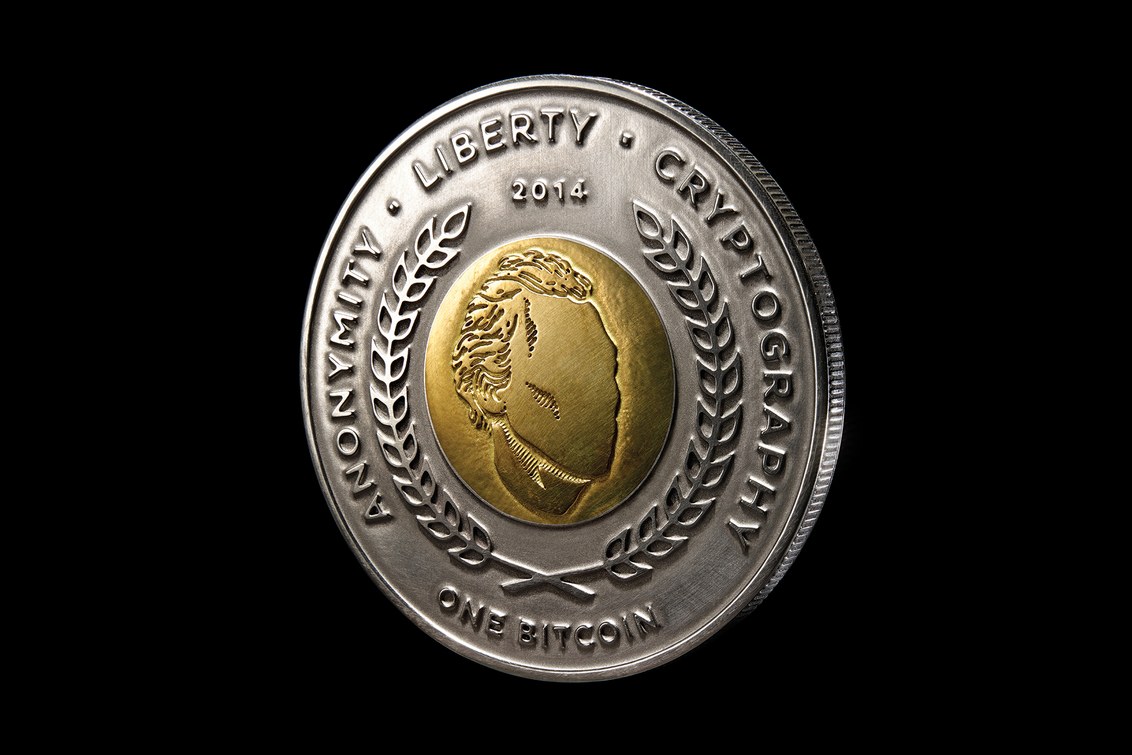
How crypto-currencies have become so important
Few people know this, but crypto-currencies have emerged as a by-product of another invention. Satoshi Nakamoto, the unknown inventor of Bitcoin, the first and ever-largest cryptocurrency, has never intended to invent a currency. His goal was to invent something; many people have failed to create digital currency before. The most important part of Satoshi's invention was that he found a way to build a decentralized digital currency system. In the 1990s, there were many attempts to create digital money, but they all failed.
After seeing all centralized attempts fail, Satoshi tried to build a digital currency system without a central entity. Like a Peer-to-Peer network for file sharing. This decision gave birth to cryptocurrency. Satoshi found the missing coins to make digital cash. The reason is a bit technical and complex, but if you understand it, you'll know more about cryptocurrencies than most people.
So, let's try to make things as easy as possible. To make digital currency or cryptocurrency, you need a payment network with accounts, balances, and transactions. It's easy to understand. A major problem that every payment network has to solve is to avoid what is called the double expense: to prevent an entity from spending twice the same amount. Usually, this is done by a central server that keeps a balance register.
In a decentralized network, you do not have this server. So you need each network entity to do this work. Each peer in the network must have a list of all transactions to check if future transactions are valid or if they are attempting to split a transaction. But how can these entities maintain consensus on these recordings?
If network peers do not agree on a single balance, no matter how small, everything is compromised. They need an absolute consensus. Usually, you take, once again, a central authority to declare the correct status of the balances. But how to reach a consensus without a central authority? Nobody knew it until Satoshi came out of nowhere. In fact, nobody thought it was even possible. Satoshi proved it was. Its main innovation has been to reach a consensus without a central authority. Crypto-currencies are part of this solution - the component that has made the solution exciting, fascinating, and has helped it spread around the world.
Miners create money and confirm transactions
Let's look at the mechanism that governs crypto-currency databases. A cryptocurrency like Bitcoin consists of a network of peers. Each pair has a record of the complete history of all transactions and therefore the balance of each account. A transaction is a file that says "Bob gives X Bitcoin to Alice" and is signed by Bob's private key. This is basic public key cryptography, nothing special at all. After the signature, a transaction is broadcast on the network, sent from one peer to another. This is the basic p2p (peer-to-peer) technology. Nothing special, again. The transaction is known almost immediately by the entire network. But it is only after a certain time that it is confirmed.
Confirmation is a critical concept for crypto-currencies. One could say that crypto-currencies are essentially a question of confirmation. As long as a transaction is not confirmed, it is pending and may be counterfeit. When a transaction is confirmed, it is engraved in stone. It is no longer falsifiable, it can not be reversed, it is part of an immutable record of historical transactions: the so-called blockchain.
Only minors can confirm transactions. It's their job in a cryptocurrency network. They take the transactions, mark them as legitimate and broadcast them in the network. After a transaction is confirmed by a minor, each node must add it to its database. She is now part of the blockchain. For this work, minors are rewarded with a token of cryptocurrency, for example with Bitcoins. Since the activity of the minor is the most important part of the cryptocurrency system, we should dwell there for a moment and take a closer look.
What are cryptocurrency miners doing concretely?
In principle, everyone can be minor. Since a decentralized network does not have the power to delegate this task, a cryptocurrency needs a mechanism to prevent a dominant party from abusing it. Imagine that someone creates thousands of peers and spreads fake transactions. The system would disorganize immediately.
Thus, Satoshi has established the rule that miners need to invest some of the work of their computers to qualify for this task. In fact, they have to find a hash - a product of a cryptographic function - that connects the new block to its predecessor. This is called Proof-of-Work. For Bitcoin, it is based on the SHA 256 Hash algorithm.
You do not need to understand the details of SHA 256. It is only important that you know that it is the basis of a cryptological puzzle that miners compete to solve. After finding a solution, a minor can build a block and add it to the blockchain. As an incentive, he has the right to add a transaction called "coinbase" which gives him a specific number of Bitcoins. This is the only way to create valid Bitcoins. Bitcoins can only be created if minors solve a cryptographic puzzle. Since the difficulty of this puzzle increases the power level of the computer that the miner has to provide, there is only a specific amount of cryptocurrency token that can be created in a given amount of time. This is part of the consensus that no network peer can transgress.
Revolutionary properties of crypto-currencies
If you think about it, Bitcoin, as a decentralized network of peers that maintain a consensus on accounts and balances, is more of a currency than the numbers you see in your bank account. What are these numbers more than database entries - a database that can be edited by people you do not see and by rules you do not know? Basically, crypto-currencies are token entries in decentralized consensus databases.
They are called CRYPTO currencies because the consensus maintenance process is secured by strong cryptography. Crypto-currencies are built on cryptography. They are not guaranteed by people or by trust, but by mathematics. An asteroid is more likely to fall on your house than a bitcoin address is compromised. To describe the properties of crypto-currencies, we have to separate the transactional and monetary properties. Although most crypto-currencies share a set of common properties, they are not engraved in stone.
Transactional properties Irreversible: After confirmation, a transaction cannot be canceled. Per person, and nobody means nobody. Neither you, nor your bank, nor the President of the United States, nor Satoshi, nor your minor. Nobody. If you send money, you send it. Nobody can help you, if you sent your funds to a scammer or if a hacker stole them from your computer. There is no safety net.
Pseudo-Anonymous: Neither transactions nor accounts are linked to real-world identities. You receive Bitcoins on so-called addresses, which are strings of about thirty characters that seem random. Although it is generally possible to analyze the flow of transactions, it is not necessarily possible to relate the real identity of users to these addresses.
Fast and global: Transactions are spread almost instantly across the network and confirmed in minutes. Because they occur in a global network of computers, they are completely indifferent to your physical location. It does not matter if I send Bitcoin to my neighbor or someone on the other side of the world.
Secure: Cryptocurrency funds are locked in a public key cryptography system. Only the owner of the private key can send cryptocurrency. Strong cryptography and the magic of large numbers makes it impossible to break this pattern. A Bitcoin address is safer than Fort Knox.
Without permission: You do not need to ask anyone to use cryptocurrency. This is the only software that everyone can download for free. After installing it, you can receive and send Bitcoins or other crypto-currencies. Nobody can stop you. There is no guard.
Cryptocurrencies: the dawn of a new economy Due mainly to their revolutionary properties, crypto-currencies have become a success. Their inventor, Satoshi Nakamoto, did not venture to dream of it. While all other attempts to create a digital currency system did not attract a critical mass of users, Bitcoin had something that provoked enthusiasm and fascination. Sometimes it's more like religion than technology. Cryptocurrencies are digital gold. A healthy currency and free from political influence. Money that promises to preserve and increase its value over time. Cryptocurrencies are also a fast and convenient means of payment with a global reach, and they are sufficiently private and anonymous to serve as a means of payment for black markets and other illegal economic activity.
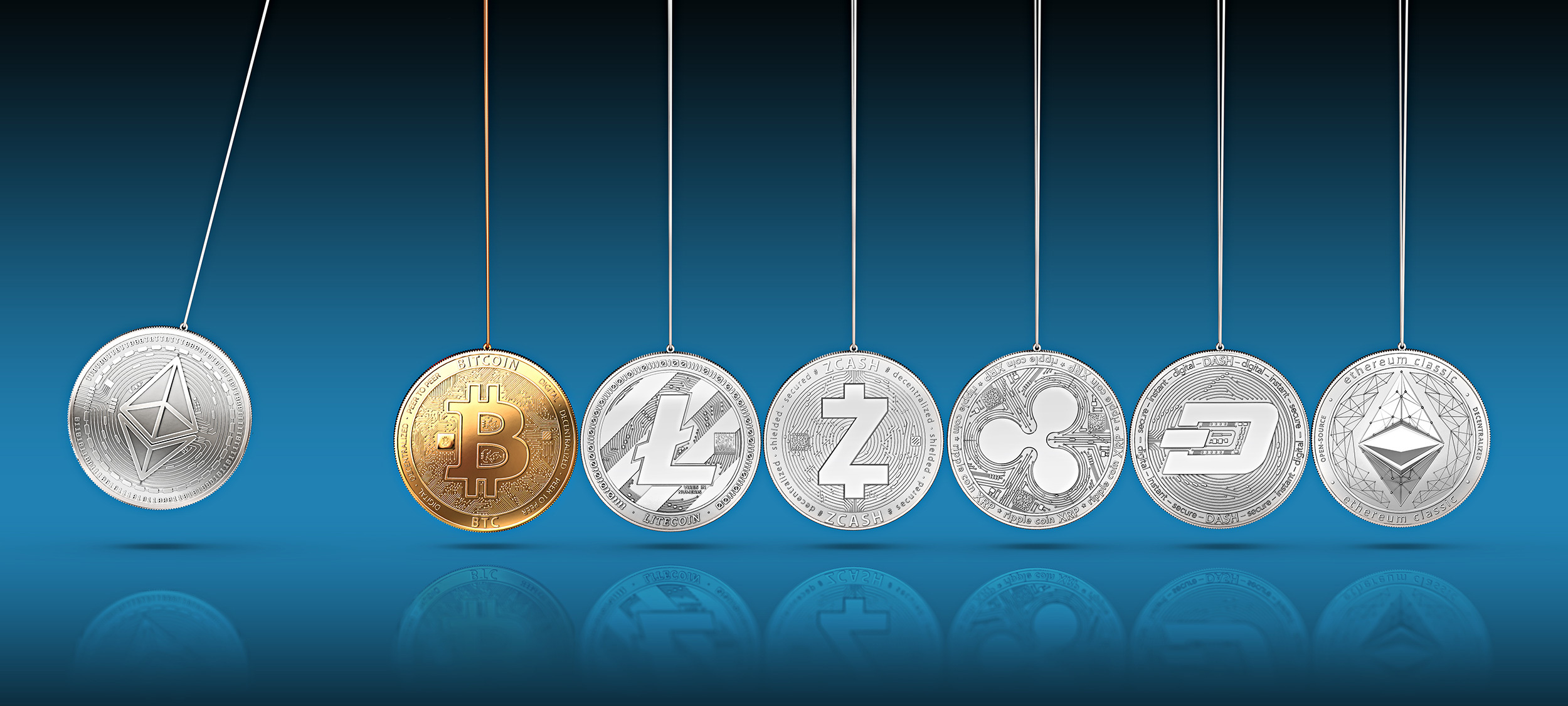
The 5 largest capitalization crypto-currencies
Bitcoin - The first cryptocurrency. The one and only, the first and most famous cryptocurrency. Bitcoin serves as a digital gold standard throughout the cryptocurrency industry. It is used as a means of global payment and is de facto the currency of cybercrime such as darknet markets or ransomware.
Ethereum - The reference cryptocurrency. The concept of young Vitalik Buterin rose to second place in the cryptocurrency hierarchy. Unlike Bitcoin, its blockchain not only validates a set of accounts and balances but also so-called states. This means that Ethereum can not only process transactions, but also complex contracts and programs. This flexibility makes Ethereum the perfect instrument for blockchain application. But that has a cost. After the hack of the DAO - a smart Ethereum-based contract - the developers decided to make a solid fork without consensus, which resulted in the emergence of Ethereum Classic. In addition to that, there are several Ethereum clones, and Ethereum itself is a host of several Tokens like DigixDAO and Augur. This makes Ethereum a family of crypto-currencies rather than a single currency.
Ripple - A cryptocurrency for finance. Perhaps the least popular - or most hated - project in the cryptocurrency community is Ripple. While Ripple has a native cryptocurrency - XRP - it's more of a network for dealing with IOUs than cryptocurrency itself. XRP, the currency, is not used to store and exchange value, but rather to protect the network against spam. Banks, however, seem to like Ripple. In any case, they are adopting the system at an increasing pace.
Litecoin - A lighter cryptocurrency. Litecoin was one of the first crypto-currencies after Bitcoin and was labeled as silver compared to digital gold bitcoin. Faster than Bitcoin, with a larger amount of token and a new mining algorithm, Litecoin was a true innovation, perfectly suited to be the smallest brother of bitcoin. "It has facilitated the emergence of several other crypto-currencies that have used its code base but made it even lighter." Examples are Dogecoin or Feathercoin. While Litecoin failed to find a real use case and lost its second place after Bitcoin, it is still actively developed and exchanged and is stored as a backup in case Bitcoin fails.
Monero - An anonymous cryptocurrency. Monero is the most important example of the cryptonite algorithm. This algorithm was invented to add the missing privacy features to Bitcoin. If you use Bitcoin, every transaction is documented in the blockchain and the transaction trace can be tracked. With the introduction of a concept called ring signature, the cryptonite algorithm has been able to break out of this path.In addition to these, there are hundreds of crypto-currencies of several families. Most of them are nothing more than attempts to reach investors and make quick money, but many promise playgrounds to test innovations in cryptocurrency technology.
What is the future of cryptocurrency? The cryptocurrency market is fast and wild. Almost every day, new crypto-currencies appear, old ones die, first-time adopters get richer and investors lose money. Every cryptocurrency comes with a promise, most of the time a great story to change the world.
Few survive the first few months, and most are pushed and abandoned immediately by speculators and live like zombie coins until the last of the holders loses hope of seeing a return on his investment. The markets are dirty. But that does not change the fact that crypto-currencies are here to stay - and here to change the world. It's already happening. People around the world are buying Bitcoin to protect themselves against the devaluation of their national currency. Especially in Asia, a live market for Bitcoin remittances has emerged, and Bitcoins using darknets of cybercrime are flourishing.
More and more companies are discovering the power of smart contracts or tokens on Ethereum, the first real application of blockchain technologies. The revolution is already underway. Institutional investors are starting to buy cryptocurrencies. Banks and governments are realizing that this invention has the potential to make them lose control. Crypto-currencies change the world. Step by step. You can both sit beside and watch - or you can be part of the story being worked on.

How to effectively anticipate the price of bitcoin?
Let's discuss some effective ways to predict the price of bitcoin for day trading. There are basically two methods for forecasting bitcoin prices using.
- Fundamental analysis - a method of valuing a security that entails attempting to measure its intrinsic value by examining related economic, financial and other qualitative and quantitative factors.
- Technical analysis - a trading discipline employed to evaluate investments and identify trading opportunities by analyzing statistical trends gathered from trading activity, such as price movement and volume.
In conclusion
Cryptocurrency is a very broad subject, but more or less easy to understand. Cryptocurrency is being used little by little in today's society. If major financial institutions fear the rise of these virtual values, we must place some confidence in the practice. In addition, cryptocurrencies can be converted into currency according to their nature. So, they are another way to make sure investments. Only, there is no point in rushing. It is necessary to take the time to get information and training because the area can be quite delicate as the value of the tokens varies from minute to minute.
Crypto-Fracking: Why advanced smart order routing is the next frontier for crypto
The power of smart order routing infrastructure on the cryptocurrency markets is exponential... and necessary.
Hydraulic Fracturing, also known as fracking, is a process where a pressurized liquid is injected into rocks forming tiny fractures to allow petroleum and natural gas to flow freely in order to extract it. There is debate over its impact on the environment, but there is no doubt it has revolutionized global energy. Fracking has created the ability to extract oil and gas where it was not possible before—it has literally created more liquidity in energy. Smart Order Routing can do the same for digital assets.
Traders looking to buy and sell cryptocurrencies at the best price need to traverse dozens of exchanges and chip away their position with no guarantee that they’re getting the best price at the moment they execute their trades. There is a better way.
At Mainbloq we’ve integrated a Streaming Smart Order Router into our TradeBloq execution management system that solves these problems. With the press of one button trades are executed across multiple exchanges to ensure the best price. Our SOR has direct, streaming connections to all of the major exchanges ensuring trades are executed faster than anyone else. Smart order routing reduces slippage since all trades executed near simultaneously, the market making bots don't have time to widen the spreads when they spot a large trade.
Before fracking, oil and natural gas could only be extracted from large, easily accessible wells. Fracking recalibrated the economics of extracting energy from smaller, less accessible sources. The same applied to digital assets—it wasn’t feasible for sophisticated traders to efficiently make large trades—that changes today. Our Smart Order Router gives traders the ability to press one button and extract slices of liquidity across dozens of exchanges and currency pairs, at the best price.
Smart Order Routing is just one small piece of what we’re creating at MainBloq. We’re building a best-in-class cloud-based modular platform joining data, tools, research, and insights for digital assets. It’s time that cryptocurrency got more sophisticated.
Ready to trade smarter on the MainBloq +Schedule a Demo
Facebook is planning to launch its own stablecoin digital currency
The United States-based global social tech giant would be the largest entrant to the consumer blockchain, and cryptocurrency space.
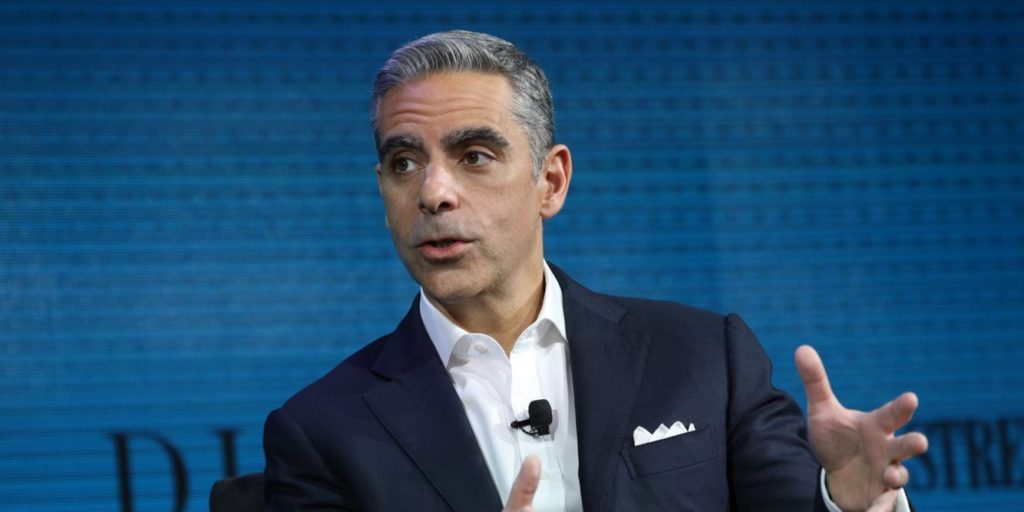
- Facebook is trying to build a cryptocurrency that would power money transfers on WhatsApp, according to a new report from Bloomberg.
- Earlier this month, business news outlet Cheddar reported that the Facebook employees had discussed with blockchain industry insiders "the idea of creating a decentralized digital currency for the social network's 2 billion users,"
Facebook could become the most important company in Crypto.
News broke yesterday that Facebook is building a stablecoin (crypto coin) that will be launched to allow WhatsApp users in India to transfer money. Of course, the immediate reaction of those in the space was to start yelling. Many people were excited, others were upset about the company’s recent privacy issues, and some felt that a Facebook stablecoin didn’t fit the authentic ethos of the crypto industry.
All of these reactions missed the mark though.
Zuckerberg and the Facebook team have never been interested in playing it safe. The highly talented team consistently looks to invent and/or grow products that change the world. If Facebook is building a stablecoin for WhatsApp, this is less about crypto and more about building a globally dominant product that changes the way billions of people live their lives.
David Marcus who leads the blockchain team is the former President of PayPal. Kevin Weil is the VP of Blockchain Product, previously served as the VP of Product at Instagram, and was once the SVP of Product at Twitter. Evan Cheng is the Director of Blockchain Engineering and was a former senior manager at Apple. And finally, Morgan Beller is the unsung hero of the group — the woman who leads blockchain strategy, but worked solo on the project for a period of time before she was able to build internal support and recruit some of the company’s best talent.
Couple these individuals with Facebook’s notorious "Growth Team" and you have a recipe for success. The Growth team is the company’s secret weapon. They are brought in like a SWAT team to solve the hardest problems by leveraging immense amounts of data and the proprietary analytical tools that have been built over the years. This team has helped four separate Facebook product teams scale their offerings to over a billion users each (Facebook main app, Messenger, Instagram, WhatsApp).
So what exactly is the potential for this team?
The holy grail would be to build the world’s dominant payment system. This would be a direct competitor to Visa and Mastercard, but it is more likely to happen than you may think. Facebook has billions of users and tens of millions of merchants. This gives the company a leg up on competitors as they bootstrap the network effects needed to lock in both sides of a marketplace.
If Facebook could successfully build the product and drive adoption, they will have a chance to transition from a social network to one of the largest financial services companies in the world. This move would allow them to take a small percentage on each transaction and reduce the dependency on their advertising-based model.
This won’t happen overnight though. Facebook needs to
(1) create a viable stablecoin (not that easy)
(2) launch the product in India’s large market (significant opposition from government and financial institutions)
(3) drive sustainable adoption,
(4) expand to other jurisdictions and other digital currencies, and then
(5) build out additional financial services to serve their customers.
It wouldn’t be surprising to see Facebook back their way into becoming a new-age bank for digital natives outside the United States.
Facebook could be the most important company in crypto. They have 2+ billion people who use their services daily. Anything they launch will quickly become the most popular product in the industry….maybe even one of the most popular products in the world.
Mark Zuckerberg has dedicated his life to changing the world. Most people in tech don't trust him and would love to see him fall. Many people no longer trust him ... and still, get your popcorn ready — I wouldn’t bet against this team (and in most cases, it boils down to the team)
TechCrunch Covered The Breaking News
Jon Russell @jonrussell For TechCrunch
Facebook looks to be jumping on the blockchain wagon with plans to introduce its own stablecoin, according to a report from Bloomberg.
The social network company — under fire for a seemingly constant stream of privacy snafus of late — created an internal blockchain divisionin May and, while there has been plenty of speculation, the exact nature of its work is unclear.
The Bloomberg report is a first solid suggestion at what will come from the new division and, according to the publication, it’ll be a stablecoin that “let[s] users transfer money on its WhatsApp messaging app, focusing first on the remittances market in India.”
Facebook offered a non-committal response.
“Like many other companies, Facebook is exploring ways to leverage the power of blockchain technology. This new small team is exploring many different applications. We don’t have anything further to share,” it told Bloomberg in a statement.
If the U.S. giant does carry out the plan that Bloomberg is reporting it would (easily) be the largest company to embrace consumer blockchain service. That’s both in terms of the size of the business — a $376 billion market cap and annual revenue of more than $40 billion — and the user base it touches. Facebook reaches more than 2.2 billion people for its core social network, 1.5 billion for WhatsApp, 1.3 billion for Messenger and a further one billion via Instagram.
That makes this a thread worth pulling, so let us get into it.
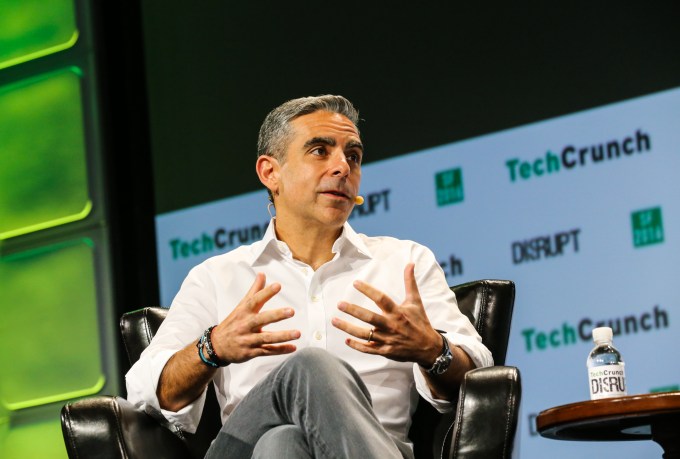
Former PayPal CEO David Marcus heads up Facebook’s blockchain division — Marcus is also a former board member at crypto exchange Coinbase
Yet another stablecoin
Stablecoins have become all the rage in the blockchain space during the second half of this year, with scores of projects popping up to provide solutions — but let’s start with why.
The concept is simple: a cryptocurrency that is pegged to a fiat currency and therefore immune to the often wild valuation swings.
Blockchain as programmable and border-less money has potential, but stability is a huge concern. Bitcoin, for example, hit a record high of nearly $20,000 one year ago; today its price is just over $4,000 but, symbolically, it fell below that figure in recent months. The ride for “altcoins” has been even bumpier.
Stablecoins offer a way to deposit money ahead of buying into Bitcoin, Ethereum or other tokens more quickly than a bank account. They also allow profits to be moved from volatile tokens and, among other things, are a more stable way of sending crypto to another person (or business) without being subject to moving prices.
Yet, despite a simple premise, there are no current examples of a proven and successful stablecoin, despite the many who have thrown their hats into the ring.
Tether, the highest-profile project, is dogged by concerns around its financial backing. The organization behind it has never shown that it has the required fiat currency to back the tokens in the market, while its value has previously slipped below $1.....
Alibaba, IBM and Mastercard Now Have The Most Blockchain Patents
Author: Peio Purlev / Source: CoinStaker | Bitcoin News

The latest blockchain patent ranking was released recently by iPR Daily. The ranking was published on August 31st and in it you can see the clear leaders in Blockchain innovation by patents filed. The top four are the giants: Alibaba, IBM, Master Card and Bank of America. The fifth spot is taken by the People’s Bank of China, China’s Central Bank. The People’s Bank of China filed 44 patent applications related to their ambitions for a Central Bank digital currency in China. The data was consolidated by iPR Daily from across the world with the help of the World Intellectual Property Organization and the International Patent System.
Alibaba leads with 90 filed patents
The first place was taken by Alibaba with 90 filed Blockchain patents with a close second going to IBM with 89 filed Blockchain...
Varanida: the Monitor Lizard of Internet Ads
The term “Varanida” comes from the official scientific designation for a monitor lizard, the Varanidae. This genus got the less formal name “monitor” due to the way in which such lizards will sometimes rear themselves up on their front legs to get a good look around, to monitor their environment, as the little fellow in the Varanida logo seems to be doing.
The omnivorous appetite of these creatures has given them a reputation for cleaning out mangroves and fields. Thus, they are a suitable mascot for a technology designed to clean out the messy internet marketing ecosystem.
Accordingly, in this newly announced project, Varanida, a company based in France, promotes a Verified Ad Program (VAD) in an effort to redefine internet marketing, using blockchains for their decentralization, fraud-resistance, and transparency.
The User Interface
Varanida has developed an add-in or extension for Google Chrome and Mozilla Firefox browsers. The extension will allow the internet user, including one with no technical sophistication, to block irritating internet ads, as detailed in their White Paper.
That idea isn’t very surprising, there are lots of ad blockers out there. What is more important, the user of Varanida’s extension, in blocking ads for him/herself, is helping to block them for a broader network of users as well (which might be a satisfying fact in itself) and is earning tokens with real near-term uses. We’ll get back to those points soon enough below.
Enthusiastic Founders
The CEO, and one of the founders of Varanida, is Anji Ismaïl, a blockchain enthusiasts who advises on a number of blockchainprojects, and who has created a cryptocurrency mining operation.
Varanida is a new expression of Ismaïl’s established interest in internet marketing. He is also the co-founder of DOZ.com, which he once described to Venturebeat as “the Uber of marketing campaigns.” The idea behind it was that a website owner should be able to order up a marketing campaign remotely, from the cloud so to speak, from marketers who (like Uber’s drivers) are paid per task.
The restructuring of Varanida has a much broader scope and purpose than that of DOZ but it is in the same line of progress. And one of Ismaïl’s co-founders is Faouzi El Yagoubi (also a co-founder of DOZ). The other is Thomas Schmider.
El Yagoubi is the chief technology officer, Schmider (whose resume includes the co-founding of Infogrames, the company that in due course purchased Atari) is the chief operating officer.
Yagoubi recently contributed a thoughtful piece to Medium about blockchains, decentralization, and encryption, one which helps make the thinking at Varanida transparent. He said that decentralization has many benefits, but there are some processes that just can’t be accomplished “the way we need them to be” without centralization. He wrote that Varanida’s real-time billing system will need to handle “real-time workloads and still provide a high level of fault tolerance” so the management group is “considering a hybrid approach, with a centralized computer system, and a decentralized ordered-hash storage system” to provide “the best of both worlds.”
Other Members of the Team
The other members of the managerial team include three distinguished software engineers: Pierre Antoine Meley, Mickael Crozes, and Marc Vicenti.
Meley has an electronics, information tech, and signal processing background. Crozes, who has a masters in computer science from SUPINFO International University, comes to Varanida with a lot of technical infrastructure experience at Amazon.com. Vicenti has a background in artificial intelligence and signed his first transaction with the Bitcoin Mainnet in 2012.
Also on board: Mathieu Sibille, senior vice president of business development (with experience in APAC, EMEA, and eastern Europe) and Jon Lord, senior ad tech consultant, who managed international sales and account teams at TradeDoubler and, more recently, worked at Criteo, a company that provides personalized online display advertisements.
Media Savvy Advisors
Varanida’s line-up of early investors and advisors displays a valuable range of backgrounds and new/social media savvy.
These advisors include, for example, Joel Comm, the bestselling author of The AdSense Code (2006) and Twitter Power (2009).
Also: Jean Christophe Conti is in. Formerly he was VP and head of the partnerships group at Yahoo where he was in charge of all partnerships, both desktop and mobile, in EMEA for: the Yahoo Display Ad Network, Yahoo Search Affiliate Network; and Right Media Platform & Exchange. of Sales for the Publishers Business Unit EMEA at AppNexus. More recently, Conti has been VP of Sales for publishers business unit, EMEA, at AppNexus.
Further, there’s Thomas Hessler, an early blockchain enthusiast and a co-founder of former CEO of Zanox, which under his leadership grew to become a global market leader in performance based online marketing until, in 2007, it was acquired by two media giants Axel Springer (Germany) and PubliGroupe (Switzerland).
We’ll mention just one more name from this field: Frédéric Montagnon is an early investor in and advisor to Varanida. Its white paper describes him as “a very active angel investor in various technology sectors.” He launched both Secret Media (an ad blocker monetization company) and Legolas Exchange (a decentralized crypto-exchange). This January Legolas raised more than $35M through its ICO in January 2018.
Montagnon recently predicted, to a reporter for a magazine that reports on the luxury industry: “Really soon everybody will be using blockchain technology in their daily lives without even noticing it the same way you use the Web without a deep understanding of how TCP-IP or HTTP works." [The point of the story was that blockchain would reduce the counterfeiting of luxury brand name goods.]

Users, Marketers, Publishers
How Varanida benefits to Publishers
But let us return to what these individuals, combined in the persona of a lizard, are up to. The Varanida white paper looks at a number of the problems that now attend internet advertising from three different points of view: that of the users, the advertisers, and the publishers of internet content.
Most users surveyed (91%) agree that ads have become even more intrusive than they were just two or three years ago. Users don’t necessarily believe that ads are bad, but the clutter of ads makes it difficult to distinguish which ones might actually be offering something valuable. Also, users are concerned that they’ve lost control over how their personal data is employed once it is ‘out there’ on the net. Indeed, most users (86%) say they have taken steps to remove digital footprints because they don’t like being targeted and pursued by the demographic characteristics and interests they have displayed.
How Varanida benefits to Advertisers
From the point of view of the advertisers, of course, “banner blindness,” the condition in which users have learned to ignore ads and focus on content, is undesirable. Marketers want their ads to reach people, and not merely to be there on the screen. The average click-through rate for a banner ad is now around 0.05%, which is enough to make one nostalgic for the ‘90s and grunge rock.
From a publishers’ point of view, too, the system is broken. Two fifths of publishers report that their ad revenues are now static or declining. They face a problem of scaling. Only a small number of publishers have the technical capabilities or the audience size necessary to serve the needs of the large advertising clients. The advertisers know this and are increasingly avoiding the small and even medium sized publishers. So even though more money than ever before gets spent on digital advertising -- if a publisher isn’t Google or Facebook, it probably isn’t getting much of it.
Meanwhile, younger users (the most desired eyeballs in the system) have caught on to the availability of ad blockers, which the Varanida white paper calls “the publishers’ nightmare.” Ad blockers now on the market don’t give users a lot of control, they aren’t customized to let users view what they would regard as useful advertising while blocking the rest.
For the reasons mentioned here, and others, it is clear to the people driving Varanida that internet advertising will have to change. Their goal is to mold that change.
How the Lizard will Work
The underlying idea is that Varanida will but itself in the center of this triangle of dissatisfied parties: users, marketers, and publishers. Users will agree to look at high-quality advertising, and will receive VAD tokens when they do. So the users win.
Advertisers and publishers will each pay a network fee. But they also win, because the new system will solve their problems as discussed above. Publishers -- except presumably for Facebook and Google, which might both want to preserve their unique status under the present system -- win by paying a fair value price for their advertising and preserving their engagement with the audience. The advertisers win by getting a fair and transparent advertising network.
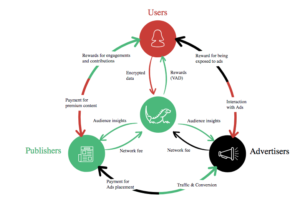
Blockchain technology is the key is achieving all this. As the white paper says, the prototype will work through the Ethereum Network, which the managing team considers the best network available at this stage in the development cycle for blockchain technology. But they will be developing their own blockchain at the same time. They have several solutions to achieving that goal under consideration, and they will be “communicating our test results as well as our final decision” on the basis of the Varanida Blockchain.
However the particulars are ironed out, the idea is to deploy “a crowdsourced advertising validation through the validation by users of the quality of the advertising.” This will be a fraud-proof system, allowing for trust within the triangle of parties just described.
The network fees will be a minute portion of advertising spend. Publishers will be earning more money from the ads they show than at present, because getting onto the Varanida network will mean cutting out the middlemen.
As noted above, the prototype phase involves the VAD token, an ERC-20 token on the Ethereum Blockchain. Users will agree to view ads, and will decide to block certain of the ads, those they deem low quality, from the network. Every time a user blocks an ad, he or she is to be rewarded with a token. Thus, they will be contributing to a list of blocked ads and advertising scripts stored on the blockchain.
Data and Tokens
Users also own their own data. They can agree to share their personal data in encrypted form and thus help guide the network’s advertisers. For this, too, they will re rewarded with tokens. Further, how much data they will share will allow a choice with various levels, rather than “all” or “nothing.”
The network will develop various uses where the VAD earned in this way can be spent. As an important example, users will be able to transfer VAD to publishers and content creators. Varanida envisions content creators welcoming this sort of payment as a measure of independence from direct ad revenue correlated to “clicks.” If so, then content creators will be incentivized toward creating better content rather than “clickbait.”
Over time, too, VAD tokens will become tradeable for other cryptocurrencies, and for fiat currency.
Publishers will also earn VAD tokens based on an auction to take place on a Real Time Bidding platform, so anything they receive from users as described above will be in the nature of a “tip” for reward-worthy content.
Publishers, in turn, will be in a position to offer VAD tokens as incentive for comments on articles, for sharing on social media, or for contributing additional content.
Timeline of the Token Sale
2018
June 26, End of Round 0. Private re-sales had offered 50% discount on tokens. In terms of ratio to bitcoin this meant 0.00000570 BTC/VAD. The result was the sale of 1.46% of the total token supply.
June 27, Round 1, an invite-only round, [though the interested are invited to request an invite] begins. The minimum contribution for this round is 3 BTC, or 30 ETH, and the target is to sell 30.15% of the new tokens. They’re selling at a 30% discount, or 0.00000900 BTC/VAD. Click here to request an invite.
August 15, Round 2, sales open to the public, begin. The public of course is subject to know-your-customer rules. The discount is down to 10%, and the target is the sale of 20.10% of the tokens.
September 15, Round 3, also open to the public. No discount. There is no fixed date for the end of Round 3. Varanida expects to sell a total of 67% of its tokens in these rounds. As to the remaining 33% of the tokens, their distribution shall be as indicated in this graph.

What the VAD is Not
The token sale announcement issued at the start of Round 1 cautioned that a VAD is not any of the following:
- is not a financial instrument, within the meaning of EU Directive 2014/65/EU of the European Parliament and of the Council of 15 May 2014 relating to markets in financial instruments,
- is not proof of ownership or a right of control It does not confer any right on any asset or share in Varanida,
- is not an electronic currency within the meaning of EU Directive 2009/110/EC of the European Parliament and of the Council of 16 September 2009 relating to access to and pursuit of the business of electronic currency institutions,
- does not qualify as a payment service within the meaning of EU Directive (2007/64/EC) of 13 November 2007 relating to payment services in the internal market, nor within the meaning of the (EU) Directive relating to payment services 2 (DSP 2) N° 2015/2366 of the European Parliament and of the Council of 25 November 2015.
VAD is, rather, “a cryptographic token used to run the Varanida Protocol, unregulated, digital asset, issued and controlled by its developers, and used and accepted only by the members of a given community.”
Varanida’s Competition
Since the troubles associated with internet advertising are not secret, it is unsurprising that there have been and still are other projects aimed at addressing those troubles, Further, some of those other projects, like Varanida, employ blockchain technology. We’ll focus here precisely on those, the more direct, competitors.
AdEx, ADX, for example, is a blockchain based ad exchange, created with the expectation that decentralized apps (Dapps) would be build on top of the exchange.
Basic Attention, BAT, is the token associated with Brave, an open source browser blocking ads and trackers. BAT includes a ledger system that anonymously tracks user attention to reward publishers.
But Varanida is importantly different. Both ADX and BAT have centralized the ad blocking function. Advertisers understandably dislike centralized blocking, which they believe essentially involves holding their work for ransom. But Varanida wants to bring the advertisers on board as part of its three-sided system, and to this end Varanida’s system is transparent and decentralized with regard to its ad blocking. Advertisers can buy in, in the belief they’re getting a fair shake and that they can learn and benefit from the feedback they receive through the network.
Also, the Varanida system includes a reputation management feature that is not matched by ADX or BAT. The Varanida platform will “introduce a specific score presented in the form of VADkarma.” Advertisers will build up their VADkarma by proposing high quality ads. Publishers will build up theirs by displaying those ads on websites that meet Varanida’s guidelines on quality, Users, too, will have a VADkarma score, to which they will add as they rate both ads and the quality of websites.
For users, the direction of the score will move only upward, there will be no mechanism by which a user’s score can drop. But for publishers and advertisers, loss of VADkarma will be possible. The idea is to deter the creation or placement of spam.
A Little Jargon
With regard to reputation management, the white paper observes that it involves “a crowdsourcing task with boolean choices.”
Some readers might not be familiar with the phrase “boolean choices,” so here is a very brief tutorial. Boolean algebra is the branch of algebra in which the values of variables are “true” or “false,” usually represented as 1 and 0. The operations of Boolean algebra are AND, OR, and NOT. Thus, George Boole, writing in the 1840s, unwittingly laid the groundwork for the formal description of the operations of a digital computer.
Boolean choice here simply means that users reacting to an ad are doing something binary: thumb up or thumb down on the ad. These binary choices are then aggregated so that there is a binary choice at another level: the ad is either deemed approved or rejected. After the process is complete for a particular ad, that advertiser’s reputational score is either increased or decreased.
A Final Thought
The white paper might have been more forthcoming about the competitive challenges that Varanida will face. For example, Papyrus (PPY), a scalable blockchain protocol with many of the same expressed aims as VAD, seems a closer kin than ADX or BAT. Yet, although PPY is mentioned in the blockchain, it is only just barely mentioned, with a specific opinion, much less a cogent distinction. It would have been a suitable matter for further comment.
Nonetheless, the bottom line is that VAD enters the market to use blockchain technology to fill a need, straightening out the mess that is internet marketing in the later part of the second decade of the 21st century. The mess is real, and the arrow aimed at it seems the right one. The market for those arrows may be large enough to accommodate a number of archers.
Be sure to follow Varanida on social
Telegram: https://t.me/varanida
Twitter: https://twitter.com/Varanida_VAD
Facebook: https://www.facebook.com/varanidaVAD
Reddit: https://www.reddit.com/r/Varanida/
Discord: https://discordapp.com/invite/7CjdaXC
Download the app: https://www.varanida.com/download/
A Blockchain for a Multi Brand Luxury Goods Registration Platform
Arianee, a Paris based startup, offers a new way of managing digital ownership and authenticity in service of distinctive brands. The underlying idea is a simple one and follows directly from the basics of blockchain technology. An asset is published in a unique chain and is linked directly to a single serial number: the burden of vouching for the authenticity of a product is shared amongst all parties engaged in transactions that concern the product. The fact of its authenticity is shared with the world.
The name “Arianee” is the French version of the name of the Greek mythological heroine whom Anglophones call Ariadne. With a thread of glittering jewels, Ariadne is said to have allowed the Athenian, Theseus, to escape the Labyrinth after he had dispatched the Minotaur. The term “Ariadne’s thread” is accordingly in common use in the software world, referencing the exhaustive application of logic to all possible options.
“There could be no better name for a structure committed to helping companies and individuals negotiate the internet – a labyrinth whose challenges far exceed those faced by Theseus – than Arianee,” says the white paper.
It also quotes Ovid:
The door, so difficult, which none of those before could find again,
By Ariadne’s aid was found, the thread that traced the way rewound.
Prosaic Damage
In less poetic moments the white paper includes some statistics on the rise and costs of counterfeiting and piracy. Working from OECD figures: counterfeiting increased from just 1.9% of the total volume of international trade in 2008 to 2.5% in 2013. In absolute terms, that 2.5% represents more than $460 billion dollars. Digital piracy in films along represented $160 billion that year.
Some luxury brands have been very aggressive of late in their pursuit of counterfeiters. But as the white paper observes, prosecuting a party for counterfeit luxury goods, can be a very complicated matter.
Arianee sees this problem as its opportunity or, it its words, “the legal paralysis resulting from the complexity … creates an ideal space” for its own efforts.
Arianee says that its platform will begin with a focus on physical/luxury goods (watches, fashion, paintings). There is no doubt, the white paper says, that “having a digital asset linked to the physical product will significantly reinforce an owner’s or potential purchaser’s trust in the authenticity of the product.”
The white paper quotes Jean-Claude Biver, heav of LVMH’s watch division, saying that “when you break the illusion of prestige, the dream, it takes away the confidence. It means slow death for luxury goods.”
At present, brands maintain customer relationship management (CRM) technologies to track interactions between individuals and the brand’s employees. Unfortunately, the distribution network is fragmentary, and customer records can be unreliable even when (which cannot be taken for granted) they even exist.
Further, if brands do manage to communicate with buyers they can find they are talking to the wrong people entirely since a product may have been purchased as a gift, or it may have been resold on a secondary market. For them, even aside from the questions of piracy etc., the ability to track who owns their branded products and to keep open lines of communication with owners will be a great business model advance.
The Token
The token ARIA is the basis of the Arianee protocol. This is an ERC20 token that will be used to pay for the features on the Arianee protocol that will require payment.
ERC-20 defines basic functionality issues such as how tokens are transferred and how users can access data about a token. It also prescribes two signals that each token takes on. Together the functions and signals ensure that Ethereum tokens of various types in the marketplace can work together: almost all wallets that support ether can support ERC-20 compliant tokens, inclusive now of ARIA.
The ARIA spent by brands will be used to compensate the authority nodes to whom the consortium model gives a role. Another portion will be reserved for platform maintenance and to seed fund promising third-party ecosystem projects that, it is expected, are in a position to provide exceptional value to the Arianee platform. The rest will go to the third party which facilitated the transaction.
Arianee acknowledges that the recent history of cryptocurrencies shows that their value can suffer from wild fluctuations, creating an obstacle for the successful function of blockchain platforms. To provide for this another element, ‘‘Gas,’’ will be used to secure the blockchain and prevent spam and malicious behavior.
Specifically, certain transactions on the blockchain (authenticity certification and messaging) will require payment both in ARIA and in Gas. ARIA can be acquired on the Arianee platform or on exchanges, but Gas is going to be distributed to verified brands, verified experts, and owners, at no cost, and on the basis of need. Each user meeting certain minimal criteria will receive a Gas allotment which can be replenished upon depletion.
The startup sees its ICO as the opportunity to bond together the members of its community. Accordingly part of the tokens will be going to early users who introduce items that require certification.
Click here to express interest in upcoming ICO Token sale
Management Team
Frederic Montagnon is chairman of the board. He has founded four companies, exiting from them with a total value of more than $400 million.
Montagnon is the 7th largest start-up investor in France, and has been active in the cryptocurrency field for five years, as both investor and influential commentator.
The head of business development is Jean-Marc Bellaiche. He is quite familiar with the issue of preserving the value of a brand name: he was formerly senior vice president of Tiffany & Co. He has also been senior partner at the Boston Consulting Group, where he led the BCS luxury, fashion, beauty, and department stores practices.
Head of operations: Christian Jorge, a serial entrepreneur in the field of web agencies and e-commerce.
Important Advisers
Arianee’s advisers include Laurent Salat, the founder of Project Theseus (which certainly keeps matters within the same mythological family). Theseus is a data analysis platform specifically dedicated to blockchains.
Fabien Potencier is also involved. Potencier is the founder of Symfony, the PHP web application framework that, beginning in 2004, has helped speed the creation and maintenance of apps and that has replaced competitive coding drudgery.
Since Arianee straddles the luxury products and high-tech worlds, it is unsurprising that it draws advisors from both of them. Its advisors with a luxury background include Patricia Barbizet, who became the first woman to head the auction house Christie’s when she was named its CEO in 2014. Fortune has ranked Barbizet number 6 in its list of the 50 most powerful women in EMEA.
Those with such a background also include Robert Jan Broer, founder and editor of Fratello Watches, the fine watch aficionado’s website. Broer is also a watch collector of importance.
Protocol
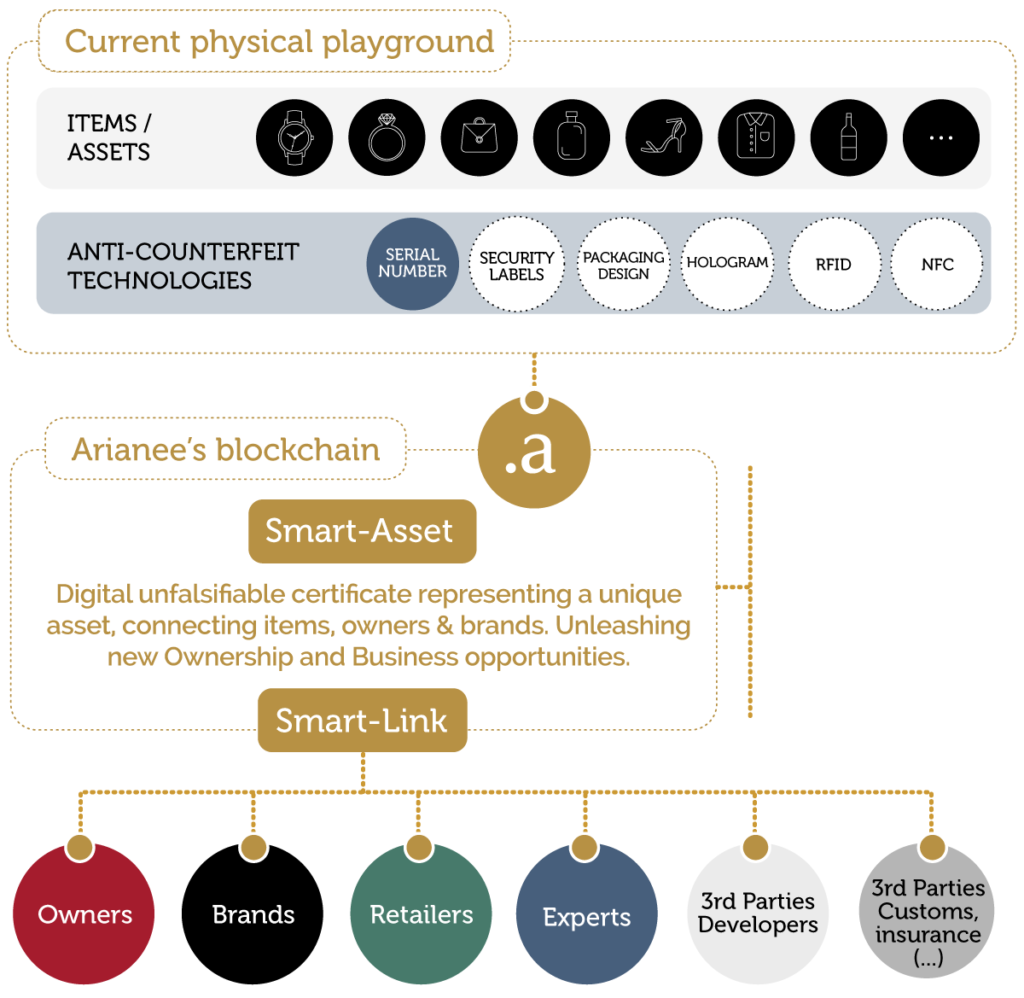
The white paper divides its discussion of the Arianee protocol into three sections, devoted to what it has to offer to, respectively, owners, brands, and the third party community.
The owners will be the primary users of the platform. They’re expected to register their products in the “Vaults,” as “Smart-Assets,” whether by listing the products themselves or by taking possession of the Smart-Asset from another user (owner, brand, or retailer). They can then enrich these Smart-Assets via certificates of authenticity delivered by brands, servicing history stamps from expert third parties, and the like.
It will be possible for an owner to lend out an asset for a definite period of time through this platform. Such a practice “will help define new use cases and build a global ecosystem with other parties.”
Each Smart-Asset will contain a log that will list all associated events, such as when it has been lent out. Owners can grant the right to third parties or brands to read the data linked to assets in the Vaults.
The second type of users critical to an understanding of the protocol are those brands themselves. They won’t have a Vault. What they will have is an Initiate Brand Data Hub. This will provide analytics in three key areas: the management of authenticated products; regular communication with product owners; and interaction with the distribution network (wholesale and retail).
Brands are rewarded for their willingness to issue Smart Authenticity certificates, which as we’ve seen enhance the assets in the owners’ vault. The reward, precisely, is that they then become able to send messages to the current owner of the certificate, whether or not that is the initial buyer.
Brands can grant the right to third parties to read data in their data hub. By allowing this, the platform allows brands to share different types of information about registered assets.
The third type of Arianee user mentioned above is the one with the all-encompassing definition, “third party community.” This includes for example experts outside of the brands, whose appraisals may enrich the products in the owners’ vaults. In order to get an appraisal, an owner will start by searching for “an expert third party who has gone through the Arianee validation process or has received delegation from a verified brand.” The owner can then check the expert’s reputation and grant that party “writing access.” The expert can then add an appraisal certificate to the Smart-Asset in the owner’s vault.
The community also includes retailers, who “need access to mechanisms that will both establish their reputation and protect them from fraud.”
More generally, Arianee expects that “enriching third parties” will develop apps (or, to be precise, Dapps) that will leverage the blockchain.
The platform will be of great benefit to insurance companies. In case of theft of or damage to an insured item that is on the platform, the insuring company will be in a position to verify authenticity and ownership, as well as to establish an accurate repair or replacement cost. They will also be in an improved position to monitor and protect themselves from insurance fraud.
To get insurance, a product owner will first grant the insurer a “read access,” either to its entire vault or to the selected assets for which insurance is desired. The insurer may then use the certificates of ownership and authenticity in the vault to estimate the value of the products involved, and thus the appropriate premium.
Another third party beneficiary of the platform is the IT service provider who will find itself a “necessary bridge between legacy IT systems and the Arianee blockchain.
The Three Models
As the white paper observes, there are three distinct blockchain models. The first, the paradigmatic blockchain, is the “public blockchain,” designed to cut out intermediaries so that everything becomes peer-to-peer. This is what Satoshi Nakamoto was doing in creating Bitcoin, after all.
In such a system, every transaction has to be verified and synched with every node, and anyone “with a computer connected to the internet can set him-herself up as a node.” This is much of the charm of the new technology, but it also has its limitations. Transactions get slower and more costly as the network grows.
An obvious response is to bring intermediaries back in, to some degree, with a “private blockchain.” Write permissions can be centralized to a single authority, and read permissions can be restricted to greater or lesser degree as the needs of the system seem to require. The generally involves one central “miner” of tokens.
Vitalik Buterin, of Ethereum, has described a typical private blockchain as “a traditional centralized system with a degree of cryptographic auditability attached.” This makes it subject to security breaches and it raises the issue of trust. It the context of something akin to the Arianee platform, it cannot be assumed that the owners or brands or other parties involved are going to trust the central authority. That may send one back to the public model, which requires no trust given the redundancy built into it.
But there is a third model, the consortium blockchain. This is an effort to preserve the pluses of each of the other two models. The mining of tokens is decentralized, though there is a miner selection process. There is also a voting or multi-party consensus mechanism (rather than the ‘proof of work’ or “proof of stake’ consensus of public blockchains). Transactions are approved at very short intervals, 100 times a msec.
It is the consortium blockchain model than, Arianee says, is “more specifically aligned with our needs” than either of the others.
Zero Knowledge Proofs
The white paper also references the Ethereum Metropolis (Byzantium) upgrade late last year, which added a new cryptographic tool to the blockchain, the zk-SNARKs. The lower case “zk” refers to “zero knowledge.” This (zk) refers to any method by which one party on a blockchain can prove to another that something is the case without revealing any information other THAN the fact that this something is the case.
The capitalized “SNARK” refers to “succinct non-interactive argument of knowledge,” which is a special variation of zk. SNARK is important in essence because it reduces the amount of computational power necessary for the “prover” to make its point to the “verifier.”
Arianee says that zk-SNARK is a “very important new tool in the Ethereum box that we will be using,” though it is vague about when the use will begin, saying only that it will implement zk-SNARKs “as soon as it will be efficient to do so.”
The gist of the paper’s discussion of zk-SNARK seems to be simply to demonstrate to readers the determination of the Arianee team to stay at the cutting edge of developments in a quickly changing technological setting.
The Timeline
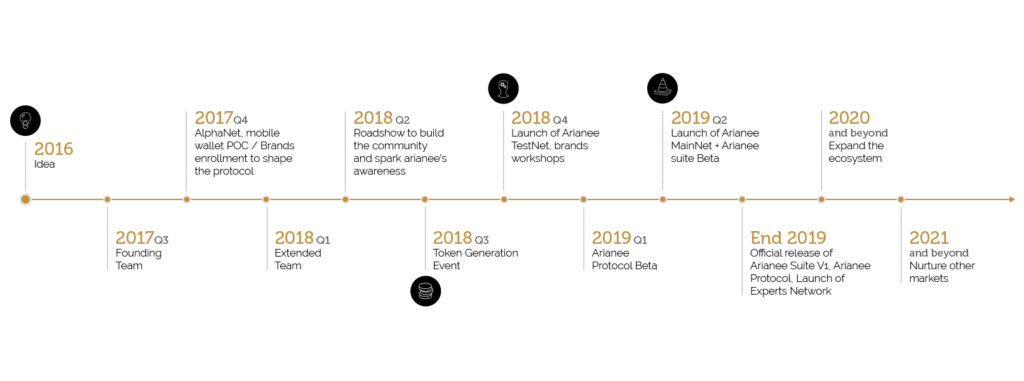
The Arianee website indicates that the founding team first came together in the third quarter of 2017. By the first quarter of 2018, Arianee had its extended team. The second quarter saw a roadshow in which this team sought to build a community and spark awareness of the needs that the platform will meet.
Going forward: Arianee plans to launch its TestNet and brands workshops in 2018 4Q. The first quarter of next year will see the protocol beta. Then, in 2019 2Q, the platform will go live.
Arianee has not yet announced dates for the various rounds of the ICO. US persons are prohibited from participating. As is customary there will be a Round 0 [private sale, to core members and advisors only], a Round 1 [broader participation but by invitation only], and a Round 2 [public sale]. The total ICO won’t last longer than 18 weeks.
There is no hard cap yet for the token sale -- one will be set after Round 0. The soft cap is $20 million.
For the public sale the price will be 5,000 satoshi per token. A satoshi is the smallest fraction of a bitcoin currently in use, a hundredth of a million BTC.
There is a minimum 30% discount from this price in Round 0 ad a 20% discount in round one.
Governance
Arianee’s governance system is a little unusual, a by-product of the fact as noted above that it uses the consortium blockchain model, mixing and matching features of the public and private models.
Arianee’s governance consists of: an executive board, a protocol board, and enterprise committees. They all can be said to supplement the Proof of Authority protocol, the machine-based consensus seeking mechanism that will certify the integrity of the blockchain.
The executive board is in charge of the allocation of the ICO funds and management of the Arianee fund. Through the Arianee fund it will distribute grants to “promising projects developed by the third-party ecosystem.”
The protocol board will be making decisions concerning the development and maintenance of the protocol as described above. Its mandate is to ensure the independence of the network, and the balance of power among authority nodes.
The enterprise committees will give voice to the businesses using the protocol. Each particular business sector involved in the ecosystem gets its own committee, to service the needs of its users, and each committee shall elect a representative to participate in the meetings of the protocol board.
Governance also entails a Know Your Business process through which every brand, expert, and independent authority node operator will be verified. Only verified companies will have access to the paid features of the system. The verification process will be run by another governance body known as the “Network Onboarding Circle,” and will be approved by the protocol board.
Final Thoughts
The working paper discloses a fascinating business plan. And certainly the luxury goods markets -- as well as other markets that might not fit into that designation but could be brought into the same system of authentication over time -- is likely to support measures that will make life more difficult for counterfeiters, black marketers, or grey markets either.
But there are a couple of matters that may give some readers pause. First, Arianee seems not yet to be willing or able to name any brands that have committed to the system. Second, the white paper is not all that clear on what role the “Gas” is supposed to play and how that is supposed to be accomplished.
Yes, it is clear that Arianee acknowledges the volatility of ETH, and so in advance of ARIA as an ERC-20 token, It says that the Gas is introduced to resolve the problems that volatility would otherwise create, but it isn’t immediately clear how that resolution is to work.
Here we conclude, and perhaps instead of Ovid we might quote the simple words of Nathaniel Hawthorne, in his Tanglewood Tales: “Eager to let Ariadne know of his success, he [Theseus] followed the guidance of the thread, and soon found himself at the entrance of the Labyrinth.” We have come a long way and you, dear reader, may now boast of your success to the Ariadnes of your life.
Be sure to follow Arianee on social
Telegram: https://t.me/arianeeproject
Twitter: https://twitter.com/ArianeeProject
Instagram: https://www.instagram.com/arianee_project/
Reddit: https://www.reddit.com/r/Arianee/
Discord: https://discordapp.com/invite/zCm2PBj
Etherisc's Smart Contract Insurance Protocol
Source: Smith + Crown
Ethrisc is developing a decentralized insurance protocol intended to support the emergence of a wide range of specialized insurance products across a variety of markets. The distributed, smart contract-based system is conceived of as a platform dApps can build on and extend with smart contract libraries and risk models that enable products like flight insurance or localized weather insurance. The aim is for the products
to be less expensive and less subjective than products from traditional insurance companies, while also being more transparent and responsive. Several insurance products are being launched on Etherisc, and a live MVP insurance product insuring against flight delays has issued ETH payouts to several policy holders. The DIP token functions as a staking requirement for anyone collecting fees on the platform.
What the Decentralized Insurance Protocol Intends to Accomplish
The modern insurance industry is built around three core elements:
- Calculated expected value of the risk: refers to the anticipated amount to be paid out over an identified time frame. If crops are being insured against failure, what do historical records and statistical tables indicate will be the expected number of failures in a given season or year? This informs premiums charged by the insurer.
- Capital cost (or reinsurance) for long tail risks: effectively are a reserve in the event that a 100 year drought sends crop failures out to multiples of anticipated amounts. Does the system have the capital reserves to cover this eventuality as well?
- Transaction costs: are the incidental costs associated with normal business operations, and are also related to the complexity and customization required per product.

If the above represent the core elements of an insurance operation, in practice, most of the world interacts with a system where two additional elements have become commonplace:
- Administration: refers to the general overhead of the large insurance companies that are required to operate their system, the costs of which must be built into the premiums individuals and businesses pay for coverage.
- Shareholder return: must be factored into premiums and decisions regarding payouts, at least to the extent that insurance companies have shareholders expecting a return on their own capital.
Etherisc proposes a decentralized protocol upon which anyone can launch smart-contract based insurance products. They contend that a blockchain-based platform has the potential to decrease transaction costs, administration costs, and remove the pressures of shareholder return, while at the same time enabling new parties to contribute both models for calculating the expected value of risk and capital for long-tail risks. Smart contracts can automate premium collection and payouts, while also making obligations more transparent. A protocol that standardizes how insurance products are presented, structured, and managed creates additional opportunities to reduce inefficiencies and administrative overhead on a corporate level, enabling the further reduction premiums. Beyond this, creating a protocol-based system, where token holders effectively replace shareholders, will remove the need to provide a return to capital, allowing a further reduction of financial obligations that filters back to premiums.
This approach lends itself in particular to a focus on parametric insurance markets, where outcomes are generally quantitative ones that are informed by sensors or other automated means that are able to communicate with smart contracts. An example can be seen in the hurricane insurance program, where payouts are based solely on recorded wind speeds, in flight insurance programs that measure delays, or in crop insurance projects based entirely upon rainfall amounts. This type of insurance generally relies on objective indicators and has payouts not determined by estimated loss, leaving insurance companies less room to fight payouts. Etherisc also argues that traditional insurance against loss will nonetheless benefit from a system that at the very least, reduces the administrative costs of managing capital.
In addition, compared to typical insurance companies that often work to avoid or reduce customer payments, the more transparent nature of a smart-contract based system should reduce both time spent disputing and disappointment with insurance policies, due to less opaque obligations. The overall result is imagined as a new type of insurance company that will be able to honor justified claims and rapidly settle outstanding issues, all while dedicating a considerably smaller percentage of premiums to administration and overhead. When Etherisc claims that a blockchain-based insurance system could be operated for an order-of-magnitude less than a traditional insurance company, the scale of the opportunity can be appreciated.
The system involves an array of on-chain actors that have direct counterparts in the traditional insurance industry.
Keepers: keepers package and offer insurance products based on smart contracts. Etherisc imagines these could be entrepreneurs, data scientists with new risk models, or traditional insurance providers offering new products. Keepers determine the premium and payouts of their products. They are also responsible for determining whether policyholders are allowed to buy policies e.g. farmers must actually plant crops to qualify for crop insurance.
They are also considered responsible for recruiting an array of other service providers as needed, discussed below. Keepers can fully integrate these functions or rely on partners.
- Underwriters: Underwriter evaluate risk models for pricing policies, determining the premiums and payouts to keep policies solvent.
- Oracles: Verify off-chain conditions that should trigger payouts. In cases of parametric insurance, systems like sensor networks or information sources could serve as oracles, or trusted third-parties could serve as final verifiers of payouts.
- License Providers: Keepers ultimately choose whether to operate with a license. Etherisc imagines that established insurance companies could earn fees for ‘renting’ or allowing others to operate under their license(s) in a particular jurisdiction. As with keepers, fees are established by the provider, encouraging competition between providers.
- Claims Adjusters: In cases where loss needs to be estimated, claims adjusters would be responsible for providing the necessary adjustments to payouts.
Risk Capital: Keepers may collateralize the product with their own capital, or acquire additional backing for their product either through collateralizing a risk pool and selling tokenized fractions of it, or acquire reinsurance through a licensed reinsurer.
Relayers: Relayers are responsible for connecting users and the products that Keepers bring to the market. These website would advertise insurance, likely from multiple Keepers. Relayers are imagined as helping police against bad products by choosing not to list them, for example, by choosing to only list products with insurance licenses, though Relayers can list any product they want. Keepers can also establish themselves as their own Relayers, offering a website on which people can sign up for policies. Flightrisk, operating today, is example of a product choosing to advertise on its own site, though presumably eventually consumers will need insurance product aggregators to discover and compare insurance products. Relayers establish their own fees for listing insurance products.

Etherisc is structured around what it calls a ‘Two-Fold Approach,’ reflecting the structure of the ‘Decentralized Insurance Foundation’ and the multiple for-profit commercial entities unique to a jurisdiction that form companies such as Ethereisc Holding AG, Etherisc US, or Etherisc MT. These jurisdictionally specific entities are in turn controlled by the Decentralized Insurance Foundation. The jurisdiction-based entities serve as the local repository of contracts and provider of platform services, allowing and encouraging new projects to join to access the smart contracts and services within the protocol. This structure should allow localization of insurance products, which are usually heavily regulated by jurisdiction.
New projects joining the protocol will in turn create a ready market for other elements of the broader Etherisc ecosystem, whether they be oracle providers, KYC services, licensed insurance companies who legally ‘rent’ their licenses by allowing firms to piggyback on their own licences, relayers, data scientists with unique risk models to cover entirely and yet-uninsurable forms of risk, or claims adjusters qualified to serve as trusted authorities for traditional insurance. As the network grows, additional capital should be attracted by the opportunity to pledge funds to the risk pools functioning as reinsurance pools within the network, standing ready to insure the larger tail-risk scenarios that might require excess capital beyond the immediate capacity of a small insurance dApp.
A Platform for New Insurance Products
This design is intended to support the emergence of new insurance products while also enabling forms of insurance recognizable today. For example, insurance products for smart contracts or cryptoassets could emerge if entities like OpenZeppelin could step in as underwriters to assess smart contract vulnerability, cryptoasset holders stepped in with risk capital, and developers and cryptoasset users purchased policies. Etherisc imagines the protocol as a potential platform for anyone to monetize an ability to develop better risk models than those that exist today or more specialized risk models in niche markets, for example, rainfall in certain specific geographic areas.
DIP tokens are used by all service providers throughout the system–any entity earning fees will be required to stake tokens in a proportion between 15-25% of their monthly income on the platform. Users are not required to use DIP to pay for insurance products or receive it as payouts. Given that premiums are collected on-chain and fee structures should be written into the insurance product smart contracts, this monthly income should be easily calculable, though the method of enforcement and potential punishment for noncollateralized activity is still being determined. If the requirement can be seamlessly enforced, DIPs value should track both overall adoption of the platform, as it is a ratio of realized revenue for all participants on the platform, and the on-chain fee structure of the participants.
For example, if $120 billion were purchased in insurance products, with an average total aggregate service provider fee of 10% resulting in $1 billion in collected monthly fees between Keepers, Relayers, and other service providers, then at least $150 million to...
Omega One, Trade Execution, and a Diagnosis
Omega One's vision is to build a bridge between traditional markets and digital assets, using world-class technology and trading algorithms. By improving liquidity and security in digital asset trading, we are laying the groundwork for a more efficient, decentralized and inclusive financial system.
On June 21, 2017, on one of the world's largest crypto exchanges, the price of ether fell 99.9% in less than a second, before rebounding just as quickly.
Omega One's Alex Gordon-Brander explains how this crash happened and how a liquidity solution like Omega One's could prevent these kinds of crashes in the future.
Omega One, a trade execution system that will use a crypto-economic protocol mediated by the Omega token (OMT), launches this summer. The token will be on sale from June through August, with the goal of $110.5 million. The system and the tokens are part of a project to resolve issues of illiquidity, insecurity, and opacity and thus to advance the mainstream appeal of cryptos.
This report on the Main Bloq looks at a number of the considerations that bear on whether that project will succeed, what the risks are, and what will be the rewards. We will be working in large part from the Omega One’s white paper.
The management team is of impressive pedigree.
The Two CEOs
Alan Keegan was the CEO when the Omega One white paper was drafted. He has since stepped down from that post but remains active with the title of co-founder. Keegan previously worked at the world’s largest hedge fund, Bridgewater Associates, as an expert on currencies and cryptocurrencies. There, his research and observations about historical trends and market conditions were studied by senior central bankers and global policymakers around the world.
Alex Gordon-Brander, of Bridgewater FX Trading and Tech, is the new CEO. When he was at Bridgewater, he managed portfolio construction apps and wrote the specifications for algorithmic trading. The smart order routing of the system he introduced there saved money for clients of that huge hedge fund manager by breaking up their large currency orders.
Smart routing is also, as it happens, an important issue in the cryptocurrency world. Indeed, in a sense, smart routing is critical to the program since if Omega One is not able to fill a trade from orders in its own dark pool, it will route the trade in whole or parts to other exchanges around the globe to complete. The Omega One white paper calls this process “liquidity harvesting.”
Before he went to Bridgewater, Gordon-Brander was with MarketAxess, and while there he acquired a patent on the MarketAxess bond trading platform.
Gordon-Brander’s LinkedIn profile says that he has been “designing alternative currency systems since before the Bitcoin white paper.”
Other Critical Team Members
Omega One’s technology partner is ConsenSys, the world’s largest blockchain company. Gordon-Brander was formerly Chief Business Architect there.
Daniel Flax is Omega One’s Chief Technology Office. He has been the CIO at Cowen and Co.,; the CTO at The Street; Vice President, Engineering, at CAN Capital; and managing director of trading systems at the New York Stock Exchange. At the NYSE he led a transition to digital trade execution and settlement.
Ron Garrett is Omega One’s chief operations officer. He has the additional title “ConsenSys Liaison,” which is itself revealing of the close connection between the two entities.
Joseph Lubin, who is both the founder of ConsenSys and a co-founder of Ethereum, is an advisor to the Omega One team. Back at the turn of the millennium, Lubin was a VP Technology, Private Wealth Management Division, Goldman Sachs. He left there to join a startup, Blacksmith Applications, which was developing trade management and processing solutions for a range of corporate clients. Lubin directed their New York office.
Two Important Advisers on Compliance Issues
Bart Chilton, a former Commodity Futures Trading Commissioner will be advising Omega One on compliance issues. From 2001 to 2005, Chilton was a senior advisor to Senator Tom Daschle (D-SD), before working at the Farm Credit Administration and eventually (2007) receiving George W. Bush’ nomination to the CFTC.
While at the CFTC, Chilton took a special interest in allegations of the illegal cartelization of the precious metals markets and their derivatives. An activist in this field, a board member of the Gold Anti-Trust Action Committee, has described Chilton as “the modern-day equivalent of Eliot Ness.”
Such a concern with the integrity of the gold and silver markets is pertinent to Chilton’s interest in Omega One’s project. After all, many people who are distrustful of the post-Nixon system of “fiat money,” and who fear the failure of that system, tend to look toward the markets in precious metals as a hedge against fiat failure. That fear has also, in recent history, been one motive for interest in alternative or cryptocurrencies.
Juan Llanos is on the advisory board of the Wall Street Blockchain Alliance. He maintains a blog, ContrarianCompliance.com, where he discusses cryptocurrencies, blockchains, and regulators.
In that blog he has emphasized that a rule of “know your customer” (KYC) has morphed into both “Know Your Transaction” (KYT) and “Know Your Funds Flow” (KYFF). In the course of his career, Llanos has helped devise a number of innovative financial products, including Mexico’s first prepaid debit card. More recently, Llanos led Bitreserve strategies on compliance and transparency.
In 2008, Llanos received permanent residency in the United States in recognition of his “extraordinary ability” in anti-money laundering and countering the financing of terrorism.
A final note on compliance: Omega One says that it is working with the law firm of Debevoise & Plimpton as well as with ConsenSys’ lawyers on meeting legal and regulatory mandates.
Debevoise is one of the leading law firms in servicing FinTech. Its part of the Blockchain Legal Industry Working Group created last year by the Enterprise Ethereum Alliance, and it has its own FinTech focused podcast, with the wonderfully apt blockchain-world name, “Appetite for Disruption.”
How is John Mack Involved?
John Mack, a former CEO of Morgan Stanley, though not a member of the management team, is an enthusiastic backer of the Omega One project and an investor. A year ago, he told a Bloomberg reporter that he had been “watching and investing in the cryptocurrency market over the last several years, and … I find Omega One to be an important next step in the emergence of this new economy.”
Mack’s involvement has certainly helped mainstream the Omega One project. But enough about the people involved in the project. What is the project? Specifically, what problems does it hope to solve?
Illiquidity, Security, Opacity
The big problems faced today by cryptocurrency markets and the parties engaged in them are, as the Omega One team sees them, as follows:
- Illiquidity, causing the realized costs of trading to climb at times to multiples of published commissions and fees;
- hacking/security risk, which especially afflicts the most liquid of cryptocurrency markets; and
- A lack of transparency, leaving parties unclear about the actual costs.
Omega One would increase liquidity by offering “a private dark pool and trading algorithms connected to all the world’s crypto exchanges.”
As of the summer of 2017 the estimated value of all crypto hacked from exchanges was above $2 billion. Omega One would improve security by “intermediating between blockchain wallets and on- or -off-chain exchanges with our own balance sheet.”
Further, it would heighten transparency by offering benchmarking and analytics to its members that would “allow them to audit the market impact of their trading.”
Some Trade Execution Particulars
The solution to the above listed problems involves a seven-step trade execution process, understood thus: a member enters a “parent order” trading against funds in the Omega Wallet; the fund availability will be verified; the parent orders will then be turned into “net orders” in the internal matching engine; based on the trading engine’s assessment of available liquidity it will break chunks of these net orders into “child orders”; these will then be broken down further into “street orders” -- these are the actual orders that are executed on an exchange; the public exchange will fill the order, thus adding funds to or withdrawing funds from the balance sheet manager; the Omega One Wallet and the Omega Private Exchange will then take care of the settlement (the back office work, as we used to call it when people were involved in it); and finally, the private exchange will confirm the transaction with the member via user interface/API.
The Omega One Wallet is “a decentralized, trust-less and non-custodial portfolio … made up of a set of linked wallets on multiple blockchains” including Ethereum, Bitcoin, and Omni. What’s new and significant about the Omega wallet, versus other wallets, even decentralized ones, is its built-in interface to the remainder of the Omega ecosystem, which will allow for secure automated settlement.
When the Omega Private Exchange receives an order, it will automatically verify and lock the funds in the relevant wallet, thus shielding the Omega One membership from settlement time mismatches across blockchains. In an ETH-BTC transaction, for example, “the member’s BTC will settle to her wallet on the bitcoin blockchain before the ETH leaves her wallet on the ethereum blockchain, enabling truly trustless listing.”
The Omega One website says, “There have not yet been any pre-sales, main sales, or tokens created at this point. Token mechanics and participation requirements (including whitelisting) will be released shortly before the token launch. Any information you may have seen about token details is inaccurate.”
The Diagnosis is a Sound One
Omega One is certainly right in its diagnosis of the difficulties that cryptocurrencies face if they are to become a mainstream investment option. A recent report by Context Capital Partners looked into investment sentiment as of the start of 2018. It said that 70% of institutions surveyed planned to increase their exposure to “alternative investments” in general in 2018, largely because the bull market in many traditional asset classes is looking old and weary.
Despite this hunger for non-traditional investments, there is still a great resistance (says the Context report) to cryptos. Only 11% of the institutions surveyed are looking to add cryptos to their portfolios. That is a sizeable niche, but it is still a niche. By way of contrast, 51% of those surveyed are planning on a greater allocation to ESG strategies this year.
So: why only 11% for cryptos? Some commentators have attributed the resistance to ‘media bias’ and some to non-rational psychological issues. But to a great significant extent the resistance is perfectly rational and it turns on exactly the three problems that Omega One has identified and addressed.
Omega One says in its white paper that it is the institutional asset managers whose buy-in “will take the crypto markets to the next level of maturity.” Its proposed trade execution system is designed to make that buy-in painless.
Omega One’s approach to addressing these problems is right. Predictably, then, it is not entirely unique. Their most direct competition comes from Ox, an exchange protocol on the Ethereum blockchain that boasts many of the same features, though with less formidable infrastructure. They are also in effect competitors with Kyber Networks (KNC). Kyber’s ICO closed on September 17, 2017. Kyber is a decentralized exchange that focuses on crypto-assets conversion.
The Wisdom of Cyber Spatial Crowds
The question of how to compare those three networks, and others with related functions, as platforms or as investments, has been much discussed on social media, inclusive of reddit.
A Reddit Exchange of Views
An exchange of views on Reddit offers a good display of what the relevant public is thinking about when it compares these systems. In that exchange, in September 2017, “self ETH trader” said that these networks are all “essentially trying to solve the same problem” and asked for guidance on “which has the most potential to succeed.”
One of the views expressed on the resulting chain was that Ox has the more realistic business plan because it is going to “deliver something soon, gain market share and then be able to iterate on the product and improve over time.”
But another participant, Voltaire585, said that he likes “the Omega One strategy for liquidity where they would fulfill your order on a non-decentralized exchange if they couldn’t settle on their order book, which will give them the training wheels till their order book is big enough to sustain itself.”
And another view, expressed by “ethfanman” was that Kyber has the inside track, because they “will support cross-chain trading in 2019 according to their roadmap, so it is not ERC-20 only.”
Jackson Palmer’s Analysis
Jackson Palmer, best known as the creator of Dogecoin, and now the proprietor of a YouTube channel on cryptocurrency with more than 25,000 subscribers, has posted a 23 minute video, picked up by CryptoGeeks.com, discussing the issue.
Palmer says that competition is heating up in the market for decentralized exchange in the Etherium space, and in his video he runs through the major players, beginning with exchanges that use old-fashioned order books. It is at about 11:20 in the video that our host comes to the issue of decentralized exchanges that dispense with order books and that trade by identifying “reserve contributors.” He begins this portion of his discussion with Kyber.
Palmer observes that this requires a KYC inquire for any reserve contributor, and he suggests that they inquiry might be scary to some potential parties.
A broader issue with such an arrangement, he adds, is that “as a buyer, you don’t have a lot of control. You basically have to agree to whatever the reserve operators are setting as the price.” The reserve operators may compete in a healthy way, but that needs to be “tested in practice.” Palmer also expresses some concern that the managers of Kyber have not been entirely transparent.
Palmer’s video doesn’t get to Omega One until about 17:30 into the discussion, and once there he begins by saying that it might not be considered a “decentralized exchange” properly speaking at all, though it has many of the same characteristics. Despite the semantic quibble, he is favorably impressed that Omega One draws upon the centralized exchanges to assist its own liquidity needs as necessary.
After making that point, he says that “the really cool thing that I see about Omega One is that you get all the benefits of a decentralized exchange” but the cost, time efficiency, and liquidity of centralized exchanges.
In general, he also says, “it’s going to take awhile to perfect” blockchain technology, cryptocurrencies, and the decentralization that many see as the promise of them both. Near the end, at about 21:30 Palmer says that the features of Omega One will likely allow it to move to cross-chains more smoothly than its competitors.
The Timeline
Cross-chains are key at this point in the development of the industry. One might argue that what the world of cryptocurrencies needs, more even than the mitigation of any or all of the three important problems listed above, is this: to become one financial space, not several. What it needs is the exchange of one cryptocurrency for another, across a very wide range of cryptos, the exchange of a ETH for a Ripple’s XRP, in a seamless and trustless way.
OMT is, as the Omega One white paper says, “ERC20 compliant with the aim of being able to leverage the functionality of the Ethereum blockchain as much as possible and seamlessly interact with other ERC20 tokens.”
The Omega One road map looks forward to a Release 1.1 - 1.x, no sooner than the final quarter of this year when the team will introduce “additional crypto crosses.” They also expect to introduce fiat currencies into the mix. In their words, that will entail bridging “the fiat/crypto membrane.”
Relatedly, the team also looks forward to adding analytic power at 1.x. “A central source recording meaningful data and interacting 24/7 with crypto exchanges will go a long way toward filling the data gap in the crypto markets” so all participants get the data they need to continue innovating.
That membrane is a legal/regulatory one as well as a technical one.
Even beyond that, Omega One looks forward to becoming a utility. Release 2.0 would depend on “technical development in the broader crypto ecosystem including improvement in the efficiency of double-blinding smart contracts, and the movement of liquidity to reliable, fully decentralized exchanges.” If this happens, then completely non-custodial and trustless liquidity will move freely through the Omega One platform, safe from information leakage or front running.
That plus a self-improving artificial intelligence trading logic engine, which could allocate OMT as fees back to member “who had a meaningful impact on improving trading logic,” would make the platform “a community owned and run a public utility.”
Why didn’t Omega One launch last year?
Omega One had planned the launch of its product and the ICO for last year. Why no launch yet?
Management has said it decided to split its capital requirements into two buckets. Rather than fund everything through a token sale, it would fund product build and launch costs through equity capital, and thereafter fund balance sheet and membership incentives through token sales. This meant that it made sense to postpone the token sale until there was a completed product and those membership incentives had immediate significance.
The distinction between these buckets was already implicit in the white paper issued before the decision was made the make the separation between them a chronological one. The white paper discussed product build and launch costs, including staff salaries, office space, equipment, etc. But the paper also said that its “primary need for capital” was “to build a large enough balance sheet that we can provide risk intermediation and settlement facilitation for a meaningful volume of daily trades.” Risk intermediation requires offsetting trades and that in turn means that the trading limit must be proportional to the size of the balance sheet.
A Final Thought
Omega One will be testing whether traders really demand a low-vol market, that is, one where even transactions large by today’s standards will have little impact. Much of their white paper is devoted to working out examples of how big an impact specified transactions can have, in a spirit of: isn’t this awful?
If there are a lot of traders who think that is, in fact, awful, then Omega One is a great play. But if the world of cryptocurrency turns out to be more accepting of volatility than this team believes, if the community has learned to shrug at such examples as just the-way-things-are, then Omega One’s near future could be a very rocky one.
Omega One WHITE PAPER 


Indian State to Use Blockchain to Streamline Food Supply
Blockchain technology is starting to gain ground by being used to address critical global issues such as food supply, fraud, and finance.
Author: Stefan Filipović / Source: thetokener.com

The world is slowly starting to realize the immense potential of the blockchain technology. The latest implementations are taking place in the field of finance, but this is just a tip of an iceberg. The huge power of blockchain lies in the fact that it could bring much more effective administrative outlook. By cutting out the middleman, time and resources could be much better used in order to create a better administrative environment for the people.
Kerala to implement blockchain to streamline supply
One of the most recent decisions regarding blockchain comes from the Indian state of Kerala. As Business Standard reports Kerala’s government has decided to apply the strategy to leverage blockchain tech in order to streamline distribution network and purchase of food supplies.
Supervision and implementation of the project will go through Kerala Development and Innovation Strategic Council (K-DISC). Every product will be registered on the newly created network. This will ensure that the information about manufacturer, origin, quality, and movement of the product are easy to find. Also, blockchain will do one of its main purposes in cutting out the middleman. This will be done in the field crop loss where...




